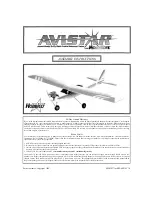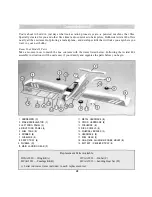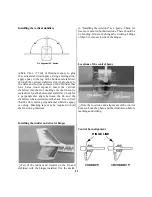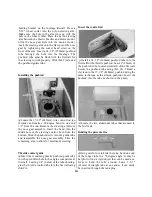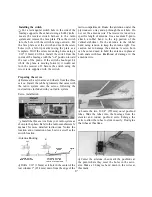
Other Items You'll Need
Glues
Choose any 6-minute epoxy, such as Great Planes®
Pro'" Epoxy, which has been formulated especially
for R/C model building. Epoxies offer a strong
bond and a variety of curing times suited for every
step of assembly. You'll also need an instant-setting
CA (cyanoacrylate), a thicker CA+, and a 30-minute
epoxy, plus rubbing alcohol and paper towels for
easy epoxy cleanup.
Hardware
Tools and accessories required for assembly:
Hobby knife Needle nose pliers
#11 knife blades Large Phillips screwdriver
#64 Rubber bands Small Phillips screwdriver
Ruler 3 ft of 3/32" fuel tubing
Drill with drill bits: 1/16", 3/32", and 3/16"
Model Engine
Power your Avistar with any high-quality, .40-size
model engine. The O.S.® .40 LA and SuperTigre®
GS-40 are just a few examples. Look for features
such as easy break-in, easy starting, efficient
carburetion and low maintenance. Check the
manufacturer's recommendations for propellers to
use with your engine.
Radio Equipment
To let you send the commands that control your
Avistar 40's "flight path," you'll need a 4-channel
aircraft radio system with four standard servos.
Many 4-channel radios include just three servos.
You may need to purchase the fourth separately.
The servos and radio receiver will be mounted on-
board your model and need to be cushioned from
jolts and vibration. One-half inch thick foam
rubber sheets are available for this purpose.
Getting Ready f o r Flight
Your Hobbico Avistar 40 trainer is ready for takeoff
in as little as 15-20 hours. Your hobby dealer or
flying instructor can help you decide what
accessories you'll need for flight. Most are one-time
only purchases—and your instructor will probably
allow you to use his field box until you can outfit
your own with a glow plug starter, fuel bulb or
pump, and "chicken stick" or electric starter. You
will need to provide your own fuel. Use glow fuel
with a 10-15% nitro blend to keep your engine
performing at its peak...and your Avistar 40 will
have the power to make you an accomplished pilot!
Other General Items Required:
Masking Tape
Epoxy Brushes
T-Pins
Clothes pins
Sandpaper
Foam Rubber
Mixing Sticks
Felt-Tip Marker
String
Paper Towels
Standard Screwdriver
Thread Locking Compound
Epoxy Mixing Cups Wing Seating Tape
Find A Flying Instructor
The best way to begin flying your Avistar 40 is with
an experienced R/C pilot or flying instructor at
your side. You'll learn faster, relax those in-flight
jitters and avoid risking your model before you're
truly ready to solo.
Where do you find an instructor? Ask at your local
hobby shop. They'll have information about flying
clubs in your area whose membership includes
qualified instructors. You can also join the
Academy of Model Aeronautics (AMA), a 165,000
member-strong national organization with more
than 2,500 chartered clubs across the country.
Through any one of them, instructor training
programs and insured newcomer training are
available. Contact the AMA at the address or phone
number below:
Academy of Model Aeronautics
5151 East Memorial Drive
Muncie, IN 47302
Toll Free: (800) 435-9262
Fax: (765) 741-0057
Web Site: http://www.modelaircraft.org
3

